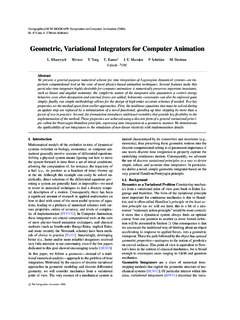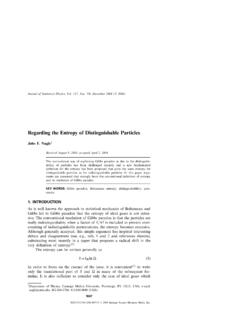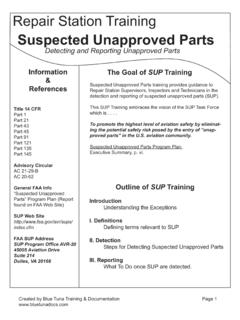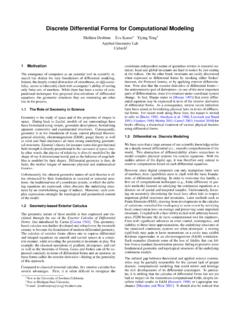Transcription of arXiv:0709.3662v4 [q-fin.ST] 3 Aug 2008
1 [ ] 3 Aug 2008 Econophysics, Statistical mechanics Approach toVictor M. YakovenkoDepartment of Physics, University of Maryland, College Park, Maryland 20742-4111, USA( , September 23, 2007, August 3, 2008)This is a review article forEncyclopedia of Complexity and System Science, to be published The terms highlighted inboldin refer to other articles in thisEncyclopedia. This paper reviews statistical models for money,wealth, and income distributions developed in the econophysics literature since late 1990s. Money, it s a gas. Pink FloydContentsGlossary1I. Definition of the subject1II. Historical Introduction2 III. Statistical mechanics of Money Distribution3A. The Boltzmann-Gibbs distribution of energy3B. Conservation of money4C. The Boltzmann-Gibbs distribution of money5D. Models with debt6E. Proportional money transfers and saving propensity 7F.
2 Additive versus multiplicative models8IV. Statistical mechanics of Wealth Distribution9A. Models with a conserved commodity9B. Models with stochastic growth of wealth10C. Empirical data on money and wealth distributions 11V. Data and Models for Income Distribution12A. Empirical data on income distribution12B. Theoretical models of income distribution15VI. Other Applications of Statistical Physics16A. Economic temperatures in different countries16B. Society as a binary alloy17 VII. Future Directions, Criticism, and Conclusions17A. Future directions17B. Criticism from economists18C. Conclusions20 VIII. Bibliography20 Books and Reviews24 GlossaryProbability densityP(x) is defined so that the prob-ability of finding a random variablexin the interval fromxtox+dxis equal toP(x) probabilityC(x) is defined as the in-tegralC(x) = xP(x)dx.
3 It gives the probability thatthe random variable exceeds a given Boltzmann-Gibbs distributiongives theprobability of finding a physical system in a state withthe energy . Its probability density is given by the ex-ponential function (1).The Gamma distributionhas the probability den-sity given by a product of an exponential function and apower-law function, as in Eq. (9).The Pareto distributionhas the probability densityP(x) 1/x1+ and the cumulative probabilityC(x) 1/x given by a power law. These expressions apply onlyfor high enough values ofxand do not apply forx Lorenz curvewas introduced by the Americaneconomist Max Lorenz to describe income and wealth in-equality. It is defined in terms of two coordinatesx(r)andy(r) given by Eq. (19). The horizontal coordinatex(r) is the fraction of the population with income belowr, and the vertical coordinatey(r) is the fraction of in-come this population accounts for.
4 Asrchanges from 0to ,xandychange from 0 to 1, parametrically defininga curve in the (x, y) Gini coefficientGwas introduced by the Italianstatistician Corrado Gini as a measure of inequality in asociety. It is defined as the area between the Lorenz curveand the straight diagonal line, divided by the area of thetriangle beneath the diagonal line. For perfect equality(everybody has the same income or wealth)G= 0, andfor total inequality (one person has all income or wealth,and the rest have nothing)G= Fokker-Planck equationis the partial differ-ential equation (22) that describes evolution in timetofthe probability densityP(r, t) of a random variablerex-periencing small random changes rduring short timeintervals t. It is also known in mathematical litera-ture as the Kolmogorov forward equation. The diffusionequation is an example of the Fokker-Planck DEFINITION OF THE SUBJECTE conophysicsis an interdisciplinary research field ap-plying methods of statistical physics to problems in eco-nomics and finance.
5 The term econophysics was firstintroduced by the prominent theoretical physicist EugeneStanley in 1995 at the conferenceDynamics of Com-plex Systems, which was held in Calcutta (now knownas Kolkata) as a satellite meeting to the STATPHYS 19conference in China [1, 2]. The term appeared in printfor the first time in the paper by Stanleyet al.[3] in2the proceedings of the Calcutta conference. The paperpresented a manifesto of the new field, arguing that be-havior of large numbers of humans (as measured, , byeconomic indices) might conform to analogs of the scalinglaws that have proved useful in describing systems com-posed of large numbers of inanimate objects [3]. Soonthe first econophysics conferences were organized:Inter-national Workshop on Econophysics, Budapest, 1997 andInternational Workshop on Econophysics and StatisticalFinance, Palermo, 1998 [2], and the bookAn Introduc-tion to Econophysics[4] was term econophysics was introduced by analogywith similar terms, such as astrophysics, geophysics, andbiophysics, which describe applications of physics to dif-ferent fields.
6 Particularly important is the parallel withbiophysics, which studies living creatures, which stillobey the laws of physics. It should be emphasized thateconophysics does not literally apply the laws of physics,such as Newton s laws or quantum mechanics , to humans,but rather uses mathematical methods developed in sta-tistical physics to study statistical properties of complexeconomic systems consisting of a large number of hu-mans. So, it may be considered as a branch of appliedtheory of probabilities. However, statistical physics isdistinctly different from mathematical statistics in its fo-cus, methods, and from physics as a quantitative science,econophysics emphasizes quantitative analysis of largeamounts of economic and financial data, which becameincreasingly available with the massive introduction ofcomputers and the Internet.
7 Econophysics distances it-self from the verbose, narrative, and ideological style ofpolitical economy and is closer toeconometricsin itsfocus. Studying mathematical models of a large numberof interacting economic agents, econophysics has muchcommon ground with theagent-based modeling andsimulation. Correspondingly, it distances itself from therepresentative-agent approach of traditional economics,which, by definition, ignores statistical and heteroge-neous aspects of the major directions in econophysics are applicationsto finance and economics. Applications to finance are de-scribed in a separate article,Econophysics of Finan-cial Markets, in this encyclopedia. Observational as-pects are covered in the articleEconophysics, Obser-vational. The present article,Econophysics, Statis-tical mechanics Approach to, concentrates primarilyon statistical distributions of money, wealth, and incomeamong interacting economic direction related to econophysics has been ad-vocated by the theoretical physicist Serge Galam sinceearly 1980 under the name ofsociophysics[5], with thefirst appearance of the term in print in Ref.
8 [6]. It echoesthe term physique sociale proposed in the nineteenthcentury by Auguste Comte, the founder of sociology. Un-like econophysics, the term sociophysics did not catchon when first introduced, but it is coming back with thepopularity of econophysics and active promotion by somephysicists [7, 8, 9]. While the principles of both fieldshave a lot in common, econophysics focuses on the nar-rower subject of economic behavior of humans, wheremore quantitative data is available, whereas sociophysicsstudies a broader range of social issues. The boundarybetween econophysics and sociophysics is not sharp, andthe two fields enjoy a good rapport [10]. A more detaileddescription of historical development in presented in HISTORICAL INTRODUCTIONS tatistical mechanics was developed in the second halfof the nineteenth century by James Clerk Maxwell, Lud-wig Boltzmann, and Josiah Willard Gibbs.
9 These physi-cists believed in the existence of atoms and developedmathematical methods for describing their statisticalproperties, such as the probability distribution of veloci-ties of molecules in a gas (the Maxwell-Boltzmann distri-bution) and the general probability distribution of stateswith different energies (the Boltzmann Gibbs distribu-tion). There are interesting connections between the de-velopment of statistical physics and statistics of socialphenomena, which were recently brought up by the sci-ence journalist Philip Ball [11, 12].Collection and study of social numbers , such as therates of death, birth, and marriage, has been growingprogressively since the seventeenth century [12, Ch. 3].The term statistics was introduced in the eighteenthcentury to denote these studies dealing with the civil states , and its practitioners were called statists.
10 Popularization of social statistics in the nineteenth cen-tury is particularly accredited to the Belgian astronomerAdolphe Quetelet. Before the 1850s, statistics was con-sidered an empirical arm of political economy, but thenit started to transform into a general method of quanti-tative analysis suitable for all disciplines. It stimulatedphysicists to develop statistical mechanics in the secondhalf of the nineteenth Clausius started development of the kinetic the-ory of gases, but it was James Clerk Maxwell who madea decisive step of deriving the probability distributionof velocities of molecules in a gas. Historical studiesshow [12, Ch. 3] that, in developing statistical mechan-ics, Maxwell was strongly influenced and encouraged bythe widespread popularity of social statistics at the approach was further developed by Ludwig Boltz-mann, who was very explicit about its origins [12, p.]
![arXiv:0706.3639v1 [cs.AI] 25 Jun 2007](/cache/preview/4/1/3/9/3/1/4/b/thumb-4139314b93ef86b7b4c2d05ebcc88e46.jpg)

![arXiv:1301.3781v3 [cs.CL] 7 Sep 2013](/cache/preview/4/d/5/0/4/3/4/0/thumb-4d504340120163c0bdf3f4678d8d217f.jpg)
![@google.com arXiv:1609.03499v2 [cs.SD] 19 Sep 2016](/cache/preview/c/3/4/9/4/6/9/b/thumb-c349469b499107d21e221f2ac908f8b2.jpg)













